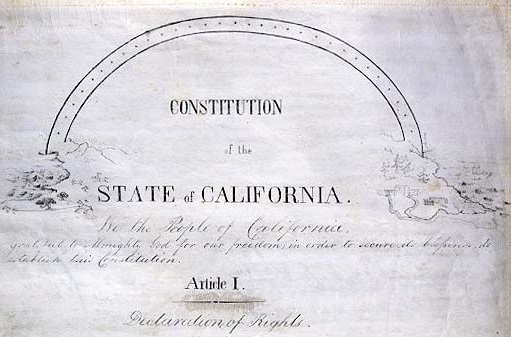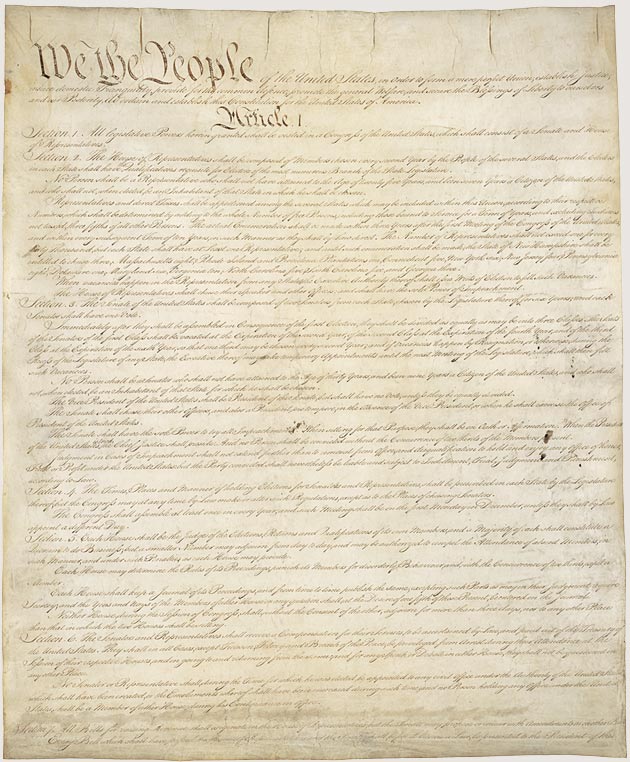
California Constitution. (Photo: www.sos.ca.gov)
CaliforniaConstitution Versus Federal Constitution
The powers of direct democracy reserved to the people
By Chris Micheli, February 15, 2019 2:00 am

The purpose of this article is to briefly compare and contrast the California and U.S. Constitutions. There are obvious similarities between the two guiding documents, but there are also important differences.
Comparing and Contrasting
The U.S. Constitution vests in the federal government certain specified powers. And, the powers that not enumerated in the federal Constitution are reserved to the states pursuant to the Tenth Amendment. This is what we term our governmental system of federalism. The states play a critical role in our federal system of governance.
The U.S. Constitution provides many of our individual rights in the Bill of Rights, while they are provided in the first Article of the California Constitution. The state constitution includes additional protections that the federal constitution does not. Federal constitutional protections apply to the states by means of the Fourteenth Amendment. As such, California and its Constitution are prohibited from violating fundamental rights provided by the United States Constitution.
While the United States Constitution is the supreme law of the land, the California Constitution sets forth the duties, powers, structure, and functions of the state government. The federal Constitution vests the federal government with specified powers, but the powers not enumerated in the federal Constitution are reserved to the states under the Tenth Amendment.
Although they are two different governing documents, there are similarities and differences between the federal and state constitutions. Both establish a form of government and provide authority for those branches of government to operate. They also provide important rights and responsibilities for the citizens of the country and state.
Here is an overview of the contents of the two constitutions:
United States Constitution
The federal constitution has seven articles, which are followed by 27 Amendments. The Articles and their Sections are the following:
Article 1 – The Legislative Branch
Section 4 – Elections, Meetings
Section 5 – Membership, Rules, Journals, Adjournment
Section 7 – Revenue Bills, Legislative Process, Presidential Veto
Section 8 – Powers of Congress
Section 9 – Limits on Congress
Section 10 – Powers Prohibited of States
Article 2 – The Executive Branch
Section 2 – Civilian Power Over Military, Cabinet, Pardon Power, Appointments
Section 3 – State of the Union, Convening Congress
Article 3 – The Judicial Branch
Section 2 – Trial by Jury, Original Jurisdiction, Jury Trials
Article 4 – The States
Section 1 – Each State to Honor all Others
Section 2 – State Citizens, Extradition
Section 4 – Republican Government
Article 6 – Debts, Supremacy, Oaths
The U.S. Constitution sets forth the three branches of government in the first three Articles. Both the federal and state constitutions provide the three branches of government in the same order: legislative, executive and judicial. The fourth Article deals with the states, followed by an article on amending the constitution, an article dealing with miscellaneous provisions, and then its ratification.
The following are the Amendments to the federal constitution (recall that the first ten Amendments are called the “Bill of Rights”):
Amendment 1 – Freedom of Religion, Press, Expression
Amendment 2 – Right to Bear Arms
Amendment 3 – Quartering of Soldiers
Amendment 4 – Search and Seizure
Amendment 5 – Trial and Punishment, Compensation for Takings
Amendment 6 – Right to Speedy Trial, Confrontation of Witnesses
Amendment 7 – Trial by Jury in Civil Cases
Amendment 8 – Cruel and Unusual Punishment
Amendment 9 – Construction of Constitution
Amendment 10 – Powers of the States and People
Amendment 11 – Judicial Limits
Amendment 12 – Choosing the President, Vice President
Amendment 13 – Slavery Abolished
Amendment 14 – Citizenship Rights
Amendment 15 – Race No Bar to Vote
Amendment 16 – Status of Income Tax Clarified
Amendment 17 – Senators Elected by Popular Vote
Amendment 18 – Liquor Abolished
Amendment 19 – Women’s Suffrage
Amendment 20 – Presidential, Congressional Terms
Amendment 21 – Amendment 18 Repealed
Amendment 22 – Presidential Term Limits
Amendment 23 – Presidential Vote for District of Columbia
Amendment 24 – Poll Taxes Barred
Amendment 25 – Presidential Disability and Succession
Amendment 26 – Voting Age Set to 18 Years
Amendment 27 – Limiting Changes to Congressional Pay
California Constitution
The state constitution has thirty-three articles (do not be deceived by the numbering as some articles do not exist). The Articles are the following:
Article I – Declaration of Rights [Sections 1 – 32]
Article II – Voting, Initiative and Referendum, and Recall [Sections 1 – 20]
Article III – State of California [Sections 1 – 9]
Article IV – Legislative [Sections 1 – 28]
Article V – Executive [Sections 1 – 14]
Article VI – Judicial [Sections 1 – 22]
Article VII – Public Officers and Employees [Sections 1 – 11]
Article IX – Education [Sections 1 – 16]
Article X – Water [Sections 1 – 7]
Article X A – Water Resources Development [Sections 1 – 8]
Article X B – Marine Resources Protection Act of 1990 [Sections 1 – 16]
Article XI – Local Government [Sections 1 – 15]
Article XII – Public Utilities [Sections 1 – 9]
Article XIII – Taxation [Sections 1 – 36]
Article XIII A – Tax Limitation [Sections 1 – 7]
Article XIII B – Government Spending Limitation [Sections 1 – 15]
Article XIII C – Voter Approval for Local Tax Levies [Sections 1 – 3]
Article XIII D – Assessment and Property-Related Fee Reform [Sections 1 – 6]
Article XIV – Labor Relations [Sections 1 – 5]
Article XV – Usury [Section 1]
Article XVI – Public Finance [Sections 1 – 23]
Article XVIII – Amending and Revising the Constitution [Sections 1 – 4]
Article XIX – Motor Vehicles Revenues [Sections 1 – 10]
Article XIX C – Enforcement of Certain Provisions [Sections 1 – 4]
Article XIX D – Vehicle License Fee Revenues for Transportation Purposes [Section 1]
Article XX – Miscellaneous Subjects [Sections 1 – 23]
Article XXII – Architectural and Engineering Services [Sections 1 – 2]
Article XXXIV – Public Housing Project Law [Sections 1 – 4]
Article XXXV – Medical Research [Sections 1 – 7]
The California Constitution begins with individual rights, then provides the powers of direct democracy reserved to the people, followed by establishment of the State, and then to the three branches of government. Like its federal counterpart, the state constitution provides the three branches of government in this order: legislative, executive and judicial.
The state constitution then proceeds to numerous Articles that have been added over the decades by the people, from transportation funding to redistricting to taxation to engineering services. Many of these Articles represent successful enactment of statewide ballot measures through the use of the initiative process.
- Recent Legal Challenges to California Statutes - December 4, 2025
- Interpretation of International Commercial Disputes - December 4, 2025
- Volume of Daily Journal Letters Submitted by Bill Authors – 2025 Update - December 3, 2025


Need help against state of California and the foreign government operating under district of columbia.
I am a man. My family has been made into a district of Columbia slave in debtor by actions of courts be the tyrant official system operating in California.
They stole and applied color of law in workers compensation case. Where hourly rate reduced by unlawful actions of courts. Hours also reduced. Was never paid correctly entire time. Damage to property. Financial loss and proceed from illegal actions of these courts. I am a man who needs freedom from enslavement and a terrorist government inflicting unlawful actions against the men and women born on the land and soil of the United States where the district of Columbia and these public servants illegally stole and applied slave law
Once all factors from a 1983 lawsuit 10 to 15million in damages That is how much they owe as of right now.
I know as a man is worth more then this. But legally as of right now. Monday calculate actual figures for pay stolen. Rough estimate 4.5million after Monday pay stolen at least 7 million